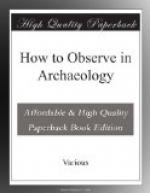Another matter which should not be neglected is the obtaining of such licences as may be required by law for the acquisition in the country or export therefrom of objects of antiquity. Advice on this matter can be obtained at the local School or National Museum.
It is possible that the traveller will begin his journey at a point other than the capital. Inquiries should be made at the London head-quarters of the Schools concerning residents at such places who may be able to give advice to intending travellers.
The traveller will doubtless bring back with him such antiquities as he is permitted to export. A word of general advice on this matter may not be out of place here. The essential value of antiquities, apart from their purely artistic interest, lies in the circumstances in which they are found. The inexperienced traveller is apt to pick up a number of objects haphazard, without accurately noting their find-spots, and even, getting tired of them, as a child of flowers that he has picked, to discard them a mile or two away. If the first act is a blunder, the second is a crime; it is better to leave them lying in place. For the same reason, it is highly desirable that objects found together (e.g. the contents of a tomb) should as far as possible be kept together, or at least that accurate record of the whole group should be made, since the archaeological value of a find may depend on a single object, apparently of small importance. Nothing, for instance, is more common, or more distressing to the numismatist, than the division of a hoard of coins among various persons before they have been examined by an expert. If they must be divided, good impressions should at least be made by one of the methods described in Chapter ii, and, if the coins are of gold or silver, the weights should be noted. This should be done even if the coins, to the inexperienced eye, appear to be all alike. The knowledge that any coin from a hoard may be of greater value than a similar coin found singly may induce finders to report such finds before dispersing them. What applies to coins is equally applicable, in various ways, to all classes of antiquities.
It is assumed that the primary object of the traveller is not speculation in the pecuniary value of the antiquities that he may acquire, although he may be not unreasonably inclined to recover some of his expenses by disposing of objects which do not appeal to him. Should that be so, although the authorities of public museums obviously cannot be agents or valuers in such transactions between the owner and private collectors, they are as obviously willing to consider offers which are made to their museums in the first instance and, if the objects are not required by them, to advise the owner in what quarter he may be likely to meet with a purchaser.
CHAPTER II
METHOD
1. Outfit.




